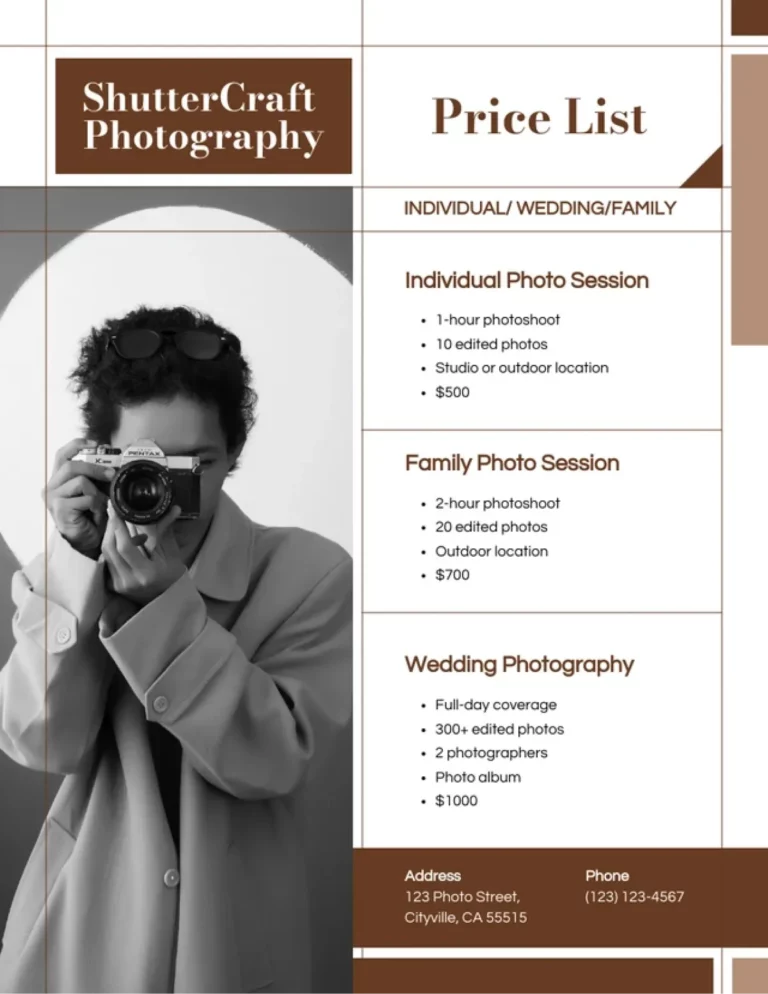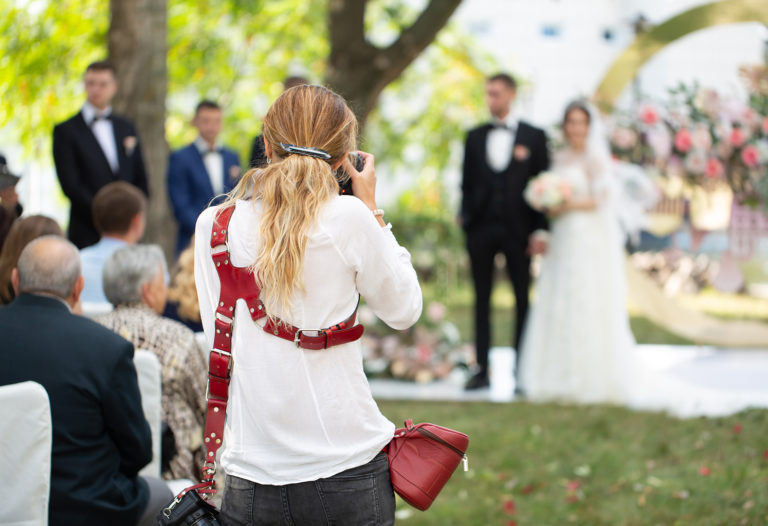You’re bought all the expensive camera gear and spent an enormous amount of time learning how to develop photos in a dark room. You read all the photography books and articles you could get your hands on, and spent hours contemplating which lenses and filters you like most.
But how to start your photography business? That’s the real question. Luckily, your Full Frame Insurance (FFI) cheering section has the answers: here’s how to develop your new company in a few easy steps.
Starting a Photography Business? Here’s What to Do
Believe it or not, in learning your craft you’ve already done the hardest part.
Starting a photography business from the ground up might seem intimidating, but it’s easier than you probably imagine.
1. Find Your Unique Artistic Voice and Style
“Photography” is an umbrella encompassing a range of professional opportunities based on different styles and niches. Here are a few examples of photography specialties you could build your business around:
- Momentous moments: You love capturing the biggest memories for others, from weddings to portraits, family photos, pregnancy shoots, new babies, and more.
- Photojournalism: You’re not afraid to hop fences, jump picket lines, or go where the news and story takes you.
- Gallery-worthy art: You have a vision, unique POV, and vivid imagination — and photographs are are the best medium for your art.
- Fashion: You can spot the difference between Prada, Fendi, and Gucci on the fly. Shooting magazine editorials and capturing the latest trends, fads, and models walking down the catwalk is just a regular Saturday afternoon for you.
- Landscape: Mountains, skies, and bodies of water activate your trigger finger. Quiet meadows and trees blowing in the wind are your happy places.
- Food/retail: Capturing the artistry and wares of others in ways that entice people to buy is right up your alley.
- Real estate: You have a knack for bringing out the best in for-sale properties and making cozy rooms look spacious.
- Commercial: Others see tradeshows, conventions, workshops, and conference rooms as boring — not you! You’re into building your business and helping others build theirs at the same time, too.

Examples of Photographers With Unique Niches
Many photographers made their mark in the industry by finding and sharing their unique styles with others.
Ansel Adams was a self-taught landscape photographer in the early 20th Century who captured images of lakes, the High Sierra mountain peaks, and more.
He also edited and published several photography books, including Making a Photograph, My Camera in the National Parks, The Portfolios of Ansel Adams, and more. Visit The Ansel Adams Gallery near Yosemite National Park.
Vivian Maier was a street photographer who captured people and life in Chicago and New York City. She amassed more than 100,000 negatives that only came to light in 2007 when John Maloof discovered them in a local Chicago thrift shop.
Maloof reconstructed most of Maier’s work, showcasing it in numerous museums worldwide. You can view street, self-portraits, and color pictures on Maier’s website.
2. Build a Portfolio That Tells a Story
You want your portfolio to showcase your best work possible so that editors, clients, judges, or whoever you need to impress sees you’re the best photographer to hire. To be compelling, it should tell a story that moves your audience and sets expectations of why they should work with you.
While you want to leverage your best work in your portfolio, you also want it to tell a story, or narrative. Here are a few ways to know which pictures to include and how to set it up as a narrative:
- Pick a theme: Land on a relatable or emotion-evoking theme (i.e., love, family, loneliness, joy, melancholy, and so on).
- Start with a highly memorable image: Choose a striking image as your first photo in the portfolio.
- Take viewers on a journey with a story-like flow: Stories have a beginning, middle, and end. For example, you could start with an amateur soccer player playing with friends, follow up with intense training, and the closing photograph being they kick the ball in the goal at a FIFA World Cup game.
Sometimes, a photographer’s judgment can be clouded when choosing the best pictures. If you’re struggling or not sure you’ve chosen the best photos to represent your work, give your portfolio to a mentor or friend for review. Getting a fresh perspective from someone else can help you distinguish the gorgeous from the “so-so” pictures.
Headshot photographer Daniel Wakefield explained the bond you shared with your subjects when taking your photos.
“A portfolio should communicate how you help people. Specifically, how you help people overcome problems specific to your industry and achieve their dreams and goals. If you do headshots, your work should show how effortlessly you help people feel comfortable in front of the camera and elevate their image to benefit their career. If your portfolio isn’t communicating how you help your specific ideal clients, you should reevaluate and perhaps narrow it down.”
3. Craft Your Business Strategy
An important part of how to start a photography business is creating a roadmap showing where your business is, where you want to take it, and the strategies you’ll use to get there.
Define Your Mission and Vision
Your mission and vision statements articulate what drives you as a photographer and what you want your business to achieve. Here are a few examples of photography mission statements:
- “I turn everyday moments into artful masterpieces.”
- “We bring your vision to life with professional, personalized photography services that leave lasting impressions.”
- “My work empowers others with striking images to capture their stories and enhance their brands.”
Write Your Business Plan
With your vision in mind, it’s time to think through the practical parts of how to start a photography business and how you’ll grow it. When you write your photography business plan, make sure it includes realistic goals, market research, financial expectations, a marketing plan, and growth targets.
Structure Your Service Menu

Determine the base services and products you plan to offer, for example: wedding photography, family sessions, school portraits, black-and-white photo packages, all-color or filtered photo packages, and so on.
You can price your services on a day, hourly, or even per-event rate. For example, $100-$300 an hour for school portraits. Or $2,000-$5,000 per day (or event) for weddings, bar mitzvahs, music festivals, or other events.
When offering pricing to clients, don’t forget to account for:
- Travel, food, and lodging
- Equipment you’ll need to bring or rent
- Props, photo booths, etc.
- Licensing and registration fees for specific locations
- Other business overhead
Also, lean into strategies that can help you get more photography clients and keep them coming back. Bundled services, package deals, share-with-a-friend offers, and reaching out to past clients when milestones are coming up can all help keep your book of business full.
4. Navigate the Legalities for Starting a Photography Business
Registering your business might not give you the same rush as pushing the shutter button, but setting up your business the right way is important. It will impact how you manage your finances, adhere to tax laws, and make your business more credible and trustworthy to prospective clients.
Decide on a Business Structure
Choose the best legal structure for starting a photography business, such as a sole proprietorship or a Limited Liability Corporation (LLC).
- With a sole proprietorship, you’re personally responsible for your business’s debts and obligations. Many freelance photographers start out as sole proprietors and then choose a corporate structure as their business grows.
- LLCs offer a separate legal identity from you, the business owner. What does that mean? It separates your business vs. personal assets, which gives you more protection if someone sues you. It also sets your company up for growth and hiring, and may provide tax advantages.
No matter which you choose, make sure you consult with a legal or tax pro to make sure your bases are covered. Learn more about business structures and get help registering your business through Incorporate.com.
Create Templates for Your Contracts and Agreements
Contracts protect you and your clients. They set expectations, guidelines, and timelines you and your clients agree to follow. Most photographer contracts specify the:
- Parties involved
- Scope, cost, and schedule of services
- List of deliverables
- Editing process
Deadlines for payments, services, edits, approvals, and deliverables - Usage rights, copyright, and ownership of film, negatives, raw images, and more.
- Client options for additional services or products — and more
Christopher Todd Griffiths, a portrait photographer, stressed the importance of having a sound contract and a non-refundable retainer instead of a deposit.
“Certain laws make a deposit fee refundable. When someone schedules a photo shoot with me, I very clearly tell them [that] to book me, they have to pay the retainer fee, and until it is paid, they are not on my schedule. Otherwise, the client does not have any responsibility to show up and can cancel last minute.”
Here are some examples of photography contract templates to use and tailor to your business needs. Contracts are legal documents, so make sure you have your contract reviewed by a professional before using it with clients.

Register Your Business
Unless you are starting a photography business as a sole proprietor, you’ll need a federal business tax ID number, also known as an Employer Identification Number (EIN). (If you are a sole proprietor, you can still get an EIN for your business — it’s just not required.)
It’s common for business clients to require you to have an EIN and submit a 1099 in order to get paid for the work you do for them. Commercial clients will also usually require you to provide proof of liability insurance coverage and may even require you to add them to your policy as an additional insured.
You’ll also need to get a business license through your state’s bureau or agency. And you may need to check local regulations to see if you need a permit through your city or Home Owners Association (HOA), especially if you are running your business from home.
You should also familiarize yourself with and follow the Corporate Transparency Act. It’s a new law passed in 2019 that requires most small businesses to file a BOI (Beneficial Ownership Information) within 30 days of starting a business. Sole proprietors, businesses in specific industries, and companies with 20 or more U.S.-based employees do not need to file.
Protect Your Reputation and Business
There are risks inherent to your work, from the potential that you could accidentally damage a venue to a client getting hurt doing a shoot or claiming you didn’t deliver what was promised. Photography liability insurance is essential to protect yourself from costly claims that could drain your bottom line, no matter how careful you are.
Insurance is a word often used as a blanket statement, but in reality, it includes a series of coverages. Understanding how each works can help you customize the way you protect your career, reputation, and business.
With FFI, your base annual policy includes:
- General liability for third-party injury or property damage claims
- Personal and advertising injury for non-physical “injuries” like advertising mistakes, slander/libel, copyright infringement, and more
- Products-completed operations for claims related to your products (like a defective digital album) or that occur after your services are completed (like a lighting fixture you set up for another photographer’s shoot falls and damages a venue)
- Damage to premises rented which is a specific allowance to cover property damages you accidentally make for a space you rent for the first seven (7) days, and afterward for fire-related damages to that space
- Medical expense limit for minor third-party medical expenses ($5,000 no-fault limit)
The optional coverages you can add to an annual policy to more fully protect your company and career include:
- Camera equipment insurance (sometimes called “inland marine”) to protect movable business gear like your camera, lenses, tripods, equipment, business laptop, smartphone, etc. in the case of theft or damage
- Failure to deliver/professional liability, also known as errors and omissions (E&O), for claims arising from mistakes (like shooting with the wrong film or failing to capture all the poses promised in a contract) or things outside of your control (like illness forcing you to cancel a shoot, your memory card failing, or your client being dissatisfied with the work you delivered)
- Cyber liability, which we call data breach insurance, helps if you’re the victim of a cybercrime like a data breach, hacked account, malware, phishing attack, etc.
Full Frame Insurance also makes it easy for you to add Additional Insureds to your policy If a venue or event organizer asks you to add them as an additional insured to your policy, you can do it right from your dashboard for a one-time fee.
- Annual policies: add one AI for $15 or $30 for unlimited
- Event policies: unlimited AIs for $5
Plus, insurance isn’t just an expense. See how you can use insurance as a marketing tool to promote your photography business.
5. Create a Standout Photography Business Brand
Building a strong brand for your new photography business takes intentionality and consistency. Here are some things to keep in mind:
- Name: Your photography business name should be memorable, unique, and easy to remember so it’s easy for people to find you.
- Logo: You need a memorable logo to go along with your name to build brand awareness. Design your own on a platform like Canva, or get help from graphic designers on freelance marketplace Fiverr for as little as $20.
- Brand voice: The tone, voice, and vocabulary you use in your marketing and branding should be consistent across all of your marketing, and resonate with the types of clients you want to attract. Work with families? Keep it wholesome and cheery. If you want to land wedding shoots, lean into the emotions brides and grooms are feeling.
You’ll also need different types of marketing materials to promote your services, such as:
- A website
- Business cards
- Referral cards
- Social profiles
- Direct mailers
- Email marketing collateral (newsletters, client guides, thank yous, referral asks)
- Flyers or brochures
- Trade show booth materials or banners
- Branded packaging
- Client guides
- A press kit

6. Attract Clients Online
From your website to your socials and digital ads, there are many ways to attract and engage clients online to get bookings. Here are some ways to use these tools independently and in tandem to build brand awareness as you start a photography business.
Make a Website for a Hub for Bookings and Sales
The right website will make attracting, booking, and fulfilling client work easier for you.
For example, incorporating basic search engine optimization (SEO) will help people find your website when searching for services like yours. It can showcase your work and portfolio, giving clients an idea of what they can expect if they hire you.
Online booking tools and contact forms make it easy for people to book your services, set up a consultation, or get a free quote. These can be embedded into your website and linked to from your social profiles and digital ads.
After a shoot, clients can return to your site and log in to view photos, make selections, and purchase add-ons like canvas prints, albums, and more — and having a web-based payment processing solution makes it easy for clients to put down deposits and make payments.
Not a web designer? No problem. You can use artificial intelligence (AI) website builders like Wix or a platform like Hostinger to quickly create your site with tools like these.
Pro tip: Google searches account for over 80% of all online searches. Claiming your free Google Business Profile, linking it to your website, and adding your business info and examples of your work can help you get seen more often in online search results.
Use Social Media for Brand Awareness and Engagement
Leveraging Instagram, Pinterest and other visual social media platforms to build an engaged audience gives your business more online visibility and can boost client interactions. Craft a social media plan for these channels to build an engaged audience:
- Instagram: Post your photos and behind-the-scenes videos of your sessions on Instagram with funny captions and relevant hashtags.
- Pinterest: Use this scrapbooking app to post photos that showcase your services, unique skills, techniques, and more.
- TikTok: Create engaging videos that promote your work and services to others.
- Facebook: Create a business page on Facebook with call to action (CTA) buttons, a link to your website, and more.
With all your social profiles – add a link to your portfolio and post pictures from your photoshoots regularly. Keep in mind that you’ll need people’s permission to use their photos to promote your business, and this is something that you can include in every contract to cover your bases.
Place Online Ads to Meet People Looking to Buy
When you’re just starting a photography business, building word of mouth and brand awareness can be a challenge. One way to kickstart your marketing is to invest in digital advertising.
If you offer regionally-based services, Facebook Ads (aka Meta Ad Platform) and Google’s Local Services Ads are a good place to start. You can also advertise on niche-specific apps (e.g., The Knot, if you’re a wedding photographer) and other photographer directories based on your niche services.
You can also get free online advertising and brand exposure simply by listing your business in directories like:
- Google (Google Business Page)
- Yelp
- The Knot
- Behance
- Diversity Photo
- Alreadymade
- Authoritative Collective
- Wonderful Machine
- Krop
- Flickr – and more
7. Develop a Network for Support and Referrals
Building connections is a big plus as you start a photography business. Shaking hands with and meeting others can potentially get you referrals, new clients, photo gigs, and tips to improve your work.
Build a Referral Network
Word-of-mouth referrals from past customers can become your best marketing, and you can actively influence it. For example, if a client sends a new customer to you, reward them with a discount on their next shoot or send a small gift as a thank you. One referral can lead to another, and eventually, you’ll have a lengthy client list.
Did you know?
Per Podium: 84% of consumers trust reviews as much as personal recommendations. Online reviews can make the difference in a client choosing you vs. a competitor, so make sure you encourage happy clients to leave reviews for you on Google, Facebook, Yelp, etc.
Getting photo gigs is only half the battle. When you’re at a shoot, why not chat with venue owners, wedding or event planners, stylists, and more when setting up or finishing a gig? You can build your network, and they may recommend you to their friends for their photography needs.
Work on Collaborative Projects
Collaborating with other photographers and creatives, such as videographers, is a great way to make sure you both get more work. For example, it’s common for photographers and videographers to partner together or cross-refer for gigs like wedding shoots. Likewise, being a top-recommend photography service by local event planners can fill up your calendar with shoots.
Plus, it can help you develop your craft — pick their brains and learn new techniques that could work for you.
Keep Growing
Joining national and local photography associations can also build your network and help you gain and share knowledge with other photographers. And you can talk with and network with other photographers at local events, conferences, exhibitions, and more.
You can also take classes to build specific photography and business skills through channels like:
- MasterClass
- Udemy
- National Geographic
- Local film schools or community college classes — and more!
What’s Next? How to Grow Your Photography Business to the Next Level

Now that you know how to start a photography business, it’s off to the races. If you’ve already covered some of these basics, you might also want to know how to level up. Here are some additional tips to help you scale and grow your brand.
Add New Income Streams
Looking for more revenue? Teaching workshops, hosting online courses, or selling photos through stock photography can serve as a side hustle for your business.
- Hosting workshops: Host in-person or online tutorial workshops to teach specific or advanced skills
- Teaching online classes: Teach livestream photography classes on apps like Discord, Twitch, YouTube, Facebook Live, etc.
- Dabbling in stock photography: When you upload photos to sites like Adobe Stock, Shutterstock, iStock, and others, they pay you each time someone uses your image
Expand Your Services
Say, for example, you’re a school photographer, but summer is a slow season because children are out for summer vacation. Try expanding your niche by doing family portraits. Or create a package for professionals who need headshots.
Are you a landscape photographer? Give walk-about classes teaching amateurs how to get better shots in the great outdoors.
Seasonal promotions can increase revenue, too. Need extra money during the holidays? Extend your services to malls during the holiday months to take photos of kids telling their holiday gift wish lists to mall Santas.
Running into clients who are also interested in videography services? Ramp up your videography skills, and get videography equipment, and add videography packages to your business menu.
Hire or Outsource
Just because you started your business alone doesn’t mean you have to run it alone. As your business grows, you may end up with more client demand than you can supply. It’s a great problem to have, but if you can’t keep up, you may be losing out on opportunities.
If you’re up to your ears in client requests and don’t want to lose out, you can either hire employees or outsource tasks like scheduling, editing, or printing to other freelance photographers.
You can say “yes” to more clients and they could fill in for you if you can’t make a photo shoot due to an illness, family emergency, or other unforeseen circumstances. Additional help can keep you sane and your business afloat like a well-oiled machine.
FAQs About How to Start a Photography Business
What Do I Need to Start a Photography Business?
To start a freelance photography business, first get your business license and insurance. Invest in quality equipment, create a menu of services, and promote your business using social media, word of mouth, and targeted ads.
How Do I Start a Photography Business With No Experience?
You can start a photography business with no experience, but it will come with some challenges. Apprenticing with an established photographer could be a smart play, and you may need to offer some free family-and-friend sessions or low-cost services to build your portfolio and generate some reviews and word-of-mouth referrals.
How Much Does It Cost To Start Up a Photography Business?
Starting a photography business can cost anywhere from $1,000 to $10,000+ to cover fees for camera equipment and other gear, website and domain names, photography insurance, advertising, marketing, and more.
How Do Photographers Attract Customers?
Photographers attract customers in different ways, such as:
- Posting on social media
- Networking
- Distributing marketing collateral
- Joining associations
- Partnering with other photographers and videographers
- Using insurance as a marketing tool
- Generating referrals and word of mouth
- Expanding service offerings or territory




